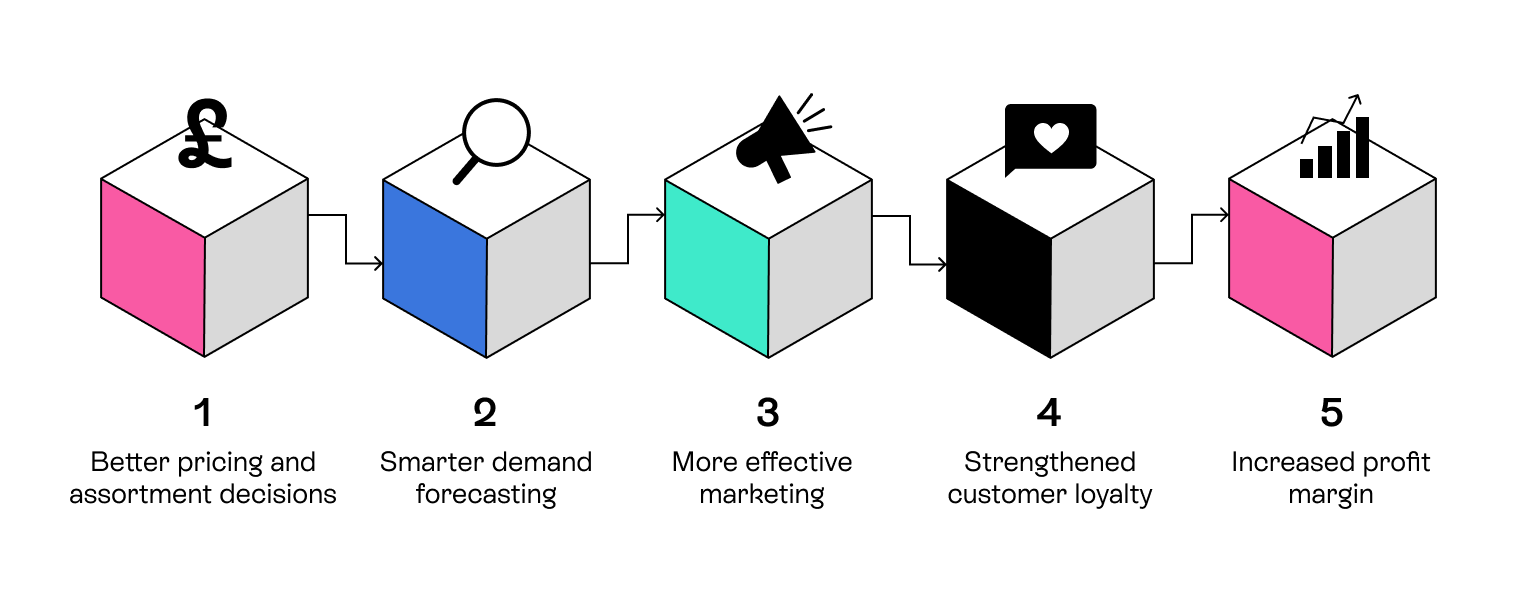
Okay, we’re calling it: 2023 was a doozy. Changing buying behaviours, increased costs, skyrocketing energy prices and ongoing supply chain woes left very few retailers unscathed.
The increased cost-of-living also had a significant impact on consumer spending – retail sales volumes (excluding fuel) decreased 2.1% last year – making forecasting and influencing demand more challenging than ever. This added extra complexity to the age-old conundrum of which products to sell, at what price and how to get them in front of the right shoppers.
The relationship between product assortment, pricing and demand is one retailers will know well. Get either of the first two wrong, and the last inevitably plummets. This is particularly true during times of economic uncertainty, since consumers are more price sensitive and tend to prioritise essential items. Last year, one in four grocery shoppers compared prices at different retailers before buying and 30% intentionally sought out promotions.
Getting the right balance between value and essentials then is key, particularly as competition increases. The right products at the right prices will attract price conscious consumers and stimulate demand, while poor ranges and low perceptions of value will push shoppers away far quicker than they might in more favourable times.
Against this backdrop, the Retail Think Tank (RTT) has warned that retailers need to maximise their efficiency and buckle up for another difficult year. RTT expects high interest rates will exacerbate the cost-of-living crisis and further dampen consumer spending. It has advised retailers to focus on understanding their customers better and getting costs and business models right if they want to survive the year ahead. That means optimising both product assortment and pricing strategies.
Cracking the crystal ball.
With 2024 set to be just as challenging as 2023, it’s going to be really obvious which retailers have optimised ranging and pricing – and which haven’t. Those that accurately anticipate demand operate efficient supply chains, keep categories lean, maximise revenue and grow sales volumes. They make informed decisions based on customer data.
A demand forecast is an essential bit of kit for understanding what customers want. Without it, retailers have no choice but to arbitrarily make product assortment and pricing decisions with little understanding of how they’ll impact demand. By the time these decisions have played out at the till, it’s too late to make changes – supply chains can’t handle abrupt about turns and you’ll invariably end up with too much stock or not enough. Overstocking is a headache many fashion retailers are currently grappling with, with stock volumes in January too high relative to expected sales (15%, up from 13% in December).
By putting customer data at the heart of both product assortment and pricing strategies, retailers can run more efficiently; understanding product relationships, how categories are shopped and the impact choice and price have on demand. This in turn forms a strong basis for demand forecasting and creates a virtuous loop, with customer data increasing forecasting accuracy to facilitate more reliable modelling and scenario planning. Retailers can then weigh up likely outcomes and make the most commercially sensible decisions, streamlining operations throughout the entire value chain – even during times of extreme uncertainty.
Product assortment drives demand.
Using customer data as a starting point for product assortment gives retailers a raft of vital information for each product and category that they wouldn’t find anywhere else. Web and mobile events, click purchases, EPOS and transaction data, even insight from advertising platforms, all provide valuable information into what customers are looking for and the drivers behind their purchasing decisions.
There are three key metrics that form the basis of a customer-centric, product assortment strategy:
- Product affinity is a substitution metric for each product, it uses customer data to map the relationships between the products sold and how likely they are to be bought together.
- Product attribution groups products based on how they’re browsed or shopped. It is a fundamental measure for both understanding products and how to get them in front of the right people.
- Customer need states mirror how a consumer approaches a certain category and clusters products based on their affinity score. This creates a decision tree that maps each subsequent choice a customer is likely to make before selecting a product.
These metrics roll up to create a detailed picture of the relationship between every item stocked and how customers respond to them. For example, if two products are highly substitutable then removing one from the range is unlikely to impact demand and might help to cut costs in the process. Similarly, product pairs with a low affinity score and good sell throughs should both be retained, since they appeal to different shopper profiles and losing either could have a negative impact on demand overall.
Product attributions and customer need state metrics enable retailers to determine a typical customer mission – the solutions they’re looking for and how they go about finding them. This is valuable insight for marketing decisions and promotional activities, but also helps to identify the products with the highest appeal, i.e., those that fulfil a need and so drive demand.

Bringing pricing into the mix.
Pricing directly impacts customer behaviour. A good pricing strategy can make a product more attractive, boost demand and enhance the perception of value. A poor pricing strategy will erode margins, reduce sales and could cause reputational damage.
Putting customer data at the centre of a pricing strategy starts with price elasticity – a measure of how demand responds to changes in price. Tweak the price too high on an elastic product and demand will plummet. Inelastic products, on the other hand, are less price sensitive and increasing the cost has little impact on whether consumers buy them or not.
Price elasticity is calculated by comparing historic data on demand levels at different price points – information that can then be used to inform pricing. An inelastic product, for example, could form part of an inflation strategy, priced higher because customers will buy it regardless.
But pricing is about more than simply setting the right price for each product. Pulling in customer data from other areas of the business helps to supercharge a pricing strategy. For example, product pairs that have a high affinity and are commonly bought together might signal good targets for promotion – a ‘buy one, get one free’ offer could increase demand and help to cross-sell, encouraging shoppers to continue buying both once the promotion ends.
Building foundational insight is the first step.
Modelling and scenario planning no longer require serious technical chops or data science expertise. Decision intelligence connects artificial intelligence (AI) with business intelligence (BI), helping those of us who aren’t data scientists to spot and understand the relationships between products and customers across all channels. It enables everyone throughout the business to make joined up, data-led decisions based on what actually motivates your customers.
With decision intelligence, retailers can tackle product assortment and pricing together. Both are intrinsically linked and, by taking a step back and thinking about them as part of a bigger picture, retailers can make decisions with the full understanding of how they’ll impact demand, supply chain and profit margins – all key considerations for a year that’s shaping up to be another doozy.
To discover how you can join the dots with decision intelligence and put customer data at the centre of your pricing and product assortment strategies, book a demo with the HyperFinity team today.


